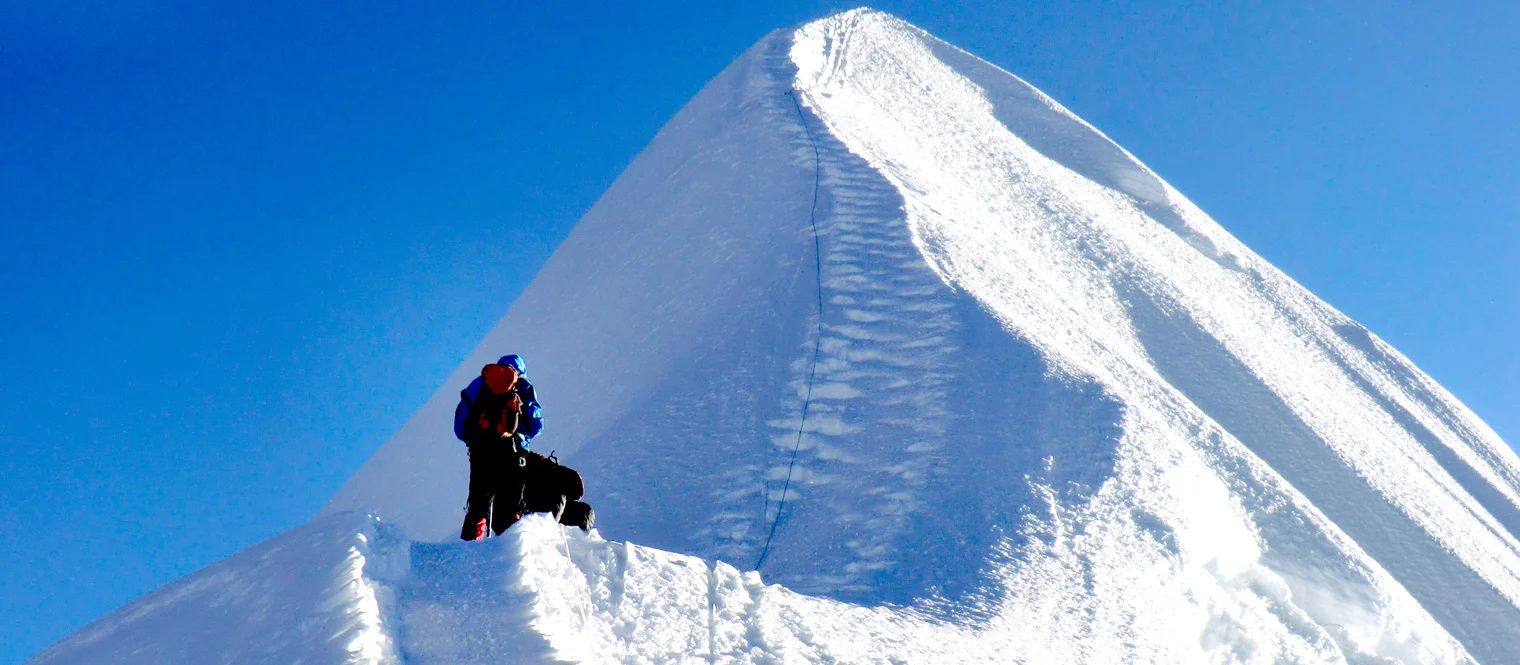Island Peak Expedition: Safety Guidelines
Section 1: Introduction – Why Safety Matters in Island Peak Climbing
One of the most popular things to do in the Himalayas of Nepal is Island Peak Climbing. This peak, which is also known as Imja Tse, is 6,189 meters high and is a popular choice for trekkers who want to experience real mountaineering without going to the highest mountains. The trail goes through Sherpa villages, past beautiful glaciers, and then up the peak with ropes, ice axes, and crampons.
Nepal's Island Peak climbing is good for beginners, but it's not an easy walk. Safety is the most important thing on the trip because of the high altitude, cold weather, and difficult ice sections. That's why it's so important to learn about the right gear, how to acclimatize properly, and how to follow expert advice before you climb Island Peak in Nepal.
If you get ready for this adventure the right way, it can be both safe and memorable. A lot of climbers use it to train before going on bigger trips in the Island Peak Himalayas. With the help of reliable companies like our Jagadamba Holidays, who offer professional guides, equipment, and help with acclimatization, you can focus on having fun and staying safe during the trip.
Island Peak Climbing is more than just getting to the top; it's also about respecting the mountain, going slowly, and making sure that every climber has a good time.
Section 2: Pre-Climb Preparation – Physical, Mental & Gear Readiness
Preparation is the most important thing to do before you start Island Peak Climbing. The climb isn't very hard, but you do need to be in good shape, have a strong will, and have the right gear.
1. Physical Preparation
- Get in shape for at least 2–3 months before the climb.
- To build stamina, do cardio exercises like running, hiking, and biking.
- Do strength training (legs, core, and upper body) because climbing requires carrying a backpack and using ropes.
- To get used to trekking conditions, practice long walks with some weight.
2. Mental Preparation
- You need to be patient and determined to reach the top.
- Get ready for long days of walking, cold weather, and thin air at high altitudes.
- Stay positive and focused. A calm mind will help you move forward safely.
3. Essential Gear
To make sure your climb of Island Peak in Nepal is safe and successful, you need the right gear:
- Boots for climbing, crampons, a harness, and a helmet
- An ice axe and ropes, which your guide team usually gives you
- A warm coat and a good sleeping bag
- Comfortable sunglasses, gloves, and trekking poles
- Personal medicines and a first-aid kit
If you have the right training and gear, Island Peak climbing in Nepal is a lot more fun and safe. You don't have to worry about missing anything because travel companies like Jagadamba Holidays make sure climbers have all the help they need, from advice on gear to tips on how to get used to the altitude.
Section 3: Acclimatization – Key to High-Altitude Safety
The height is one of the hardest things about Island Peak Climbing. The air gets thinner as you go higher, and your body needs time to get used to it. The most important thing to do to stay safe in the Island Peak Himalayas is to acclimatize.
1. Why Acclimatization Matters
- Trekkers can get altitude sickness if they don't take enough rest days.
- Common signs include headaches, dizziness, loss of appetite, and trouble sleeping.
- If you don't pay attention to these signs, the climb could be dangerous.
2. How Acclimatization Works
- You spend a few days hiking through villages like Namche Bazaar and Dingboche on the Island Peak Nepal climb.
- These stops aren't just for resting; they're also to help your body adjust to the new height.
- Your body will adjust even faster if you take short hikes on your rest days.
3. Safety Tips for Acclimatization
- Don't hurry; walk slowly. The most important rule is "Climb high, sleep low."
- Stay away from alcohol and drink a lot of water.
- To stay strong, eat warm, energy-rich meals.
- Always let your guide know if you're not feeling well.
Climbing the peak is much safer and more fun after you get used to the altitude. Jagadamba Holidays is one of many trustworthy trekking companies that always include enough acclimatization days in your trip so that you can reach the top with confidence.
Section 4: Technical Climbing Safety – On the Mountain
When you start Island Peak Climbing for real, the trip gets more difficult. You can't just walk up the Island Peak Himalayas. You have to use ropes, harnesses, and crampons to get to the top safely.
Following the right safety rules is the most important thing.
1. Using the Right Gear Correctly
- Ropes, an ice axe, a harness, a helmet, and crampons are all important tools for climbing.
- Before you climb, make sure you know how to use each piece of gear.
- Your guide will check your gear and show you how to safely clip into fixed ropes while you climb Island Peak in Nepal.
2. Rope and Ladder Safety
- You might need to use ladders to cross crevasses in the glacier sections.
- Always clip into the rope line and take one step at a time.
- Never rush or panic; trust your climbing guide.
3. Weather Awareness
- The weather in the mountains can change quickly.
- It can be dangerous to climb the peak when there are strong winds or sudden snowstorms.
- Guides from well-known companies like Jagadamba Holidays always look at the weather reports and choose the best time to try to reach the top.
4. Teamwork and Communication
- Working together is the only way to be safe on the mountain.
- Always do what your guide tells you to do.
- It's never safe to hide how you feel, so let someone know right away if you're tired, dizzy, or sick.
You can make your Island Peak climb safe and unforgettable by respecting the mountain, using the right climbing techniques, and following your guide's safety rules.
Section 5: Emergency Preparedness – Planning for the Unexpected
The Himalayas are beautiful to climb, but they can also be dangerous. Even if you plan your Island Peak climbing trip well, things like sudden changes in the weather, altitude sickness, or injuries can still happen. That’s why being prepared is very important.
1. First Aid & Medical Safety
- Always have a small first aid kit with you that has things like bandages, headache and stomach medicines, and blister medicine.
- Most guides on the Island Peak Nepal climb know how to do first aid in the mountains and can deal with small problems.
2. Altitude-Related Emergencies
- AMS, or Acute Mountain Sickness, can happen at high altitudes. It can lead to more serious conditions like HAPE or HACE.
- If symptoms get worse, the best thing to do is go down right away.
- Jagadamba Holidays makes sure that climbers on Island Peak in Nepal have enough time to get used to the altitude to lower risks.
3. Communication & Rescue Plans
- Evacuation may be necessary in case of a serious emergency.
- Satellite phones, radios, and mobile networks (which are only available in some places) help climbers stay in touch.
- If you need it, there is a helicopter rescue option in the Island Peak Himalayas, but you must have travel insurance that covers climbing at high altitudes.
4. Weather & Backup Plans
- The weather in the mountains can change quickly. Heavy winds or snowstorms can make it hard to climb Island Peak.
- For safety, always plan for extra days in your schedule.
5. Trusting Your Guide
- Companies like Jagadamba Holidays hire professional guides who know how to deal with emergencies and when to keep going or turn back.
- Taking their advice can save lives.
Climbers can enjoy the adventure while keeping safety as their top priority if they are always ready for the unexpected.
Section 6: Post-Climb Safety & Recovery
It's a big deal to finish the Island Peak Climbing. You will never forget standing on top of the Island Peak Himalayas at 6,189 meters, but your safety doesn't end when the climb is over. It's just as important to take care of your body and mind after the trip.
1. Gradual Descent
- Always be careful when you go down after reaching the top.
- Climbers get tired on the way down, which leads to a lot of accidents.
- Guides on the Island Peak Nepal climb make sure you go down slowly and safely.
2. Rest & Hydration
- To help your body recover from the thin air, drink a lot of water.
- After several days of hard trekking and climbing, it's important to get enough rest and eat well.
3. Monitoring Health
- Some climbers may still have symptoms related to altitude even after they come down.
- If your dizziness, headache, or nausea doesn't go away, see a doctor.
- Jagadamba Holidays makes sure that climbers are watched after the Island Peak climb for any health issues.
4. Emotional Recovery
- It's not just physical to climb to the top; it's also mental.
- After the challenge, it's good for your mind to spend a few days relaxing in villages at lower altitudes or in Kathmandu.
5. Celebrating Your Achievement
- It's not easy to do Island Peak Climbing in Nepal.
- A lot of climbers use this time to think about their lives, tell their stories, and plan their next trip.
Taking care of yourself after climbing makes sure you get home safe, strong, and ready to remember one of the best times of your life.






